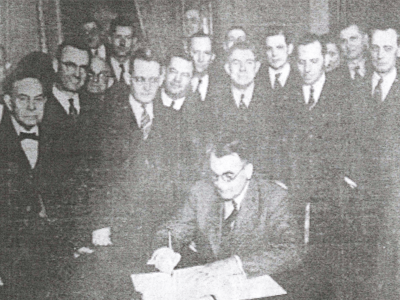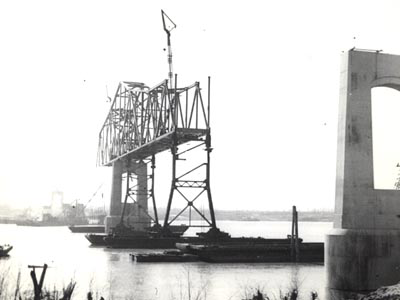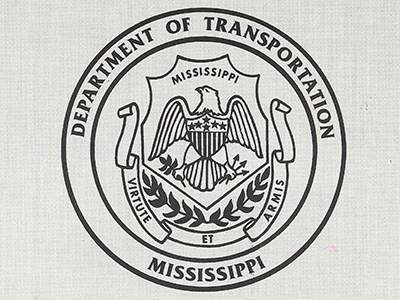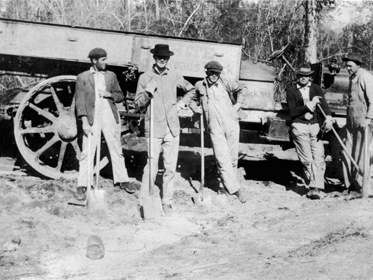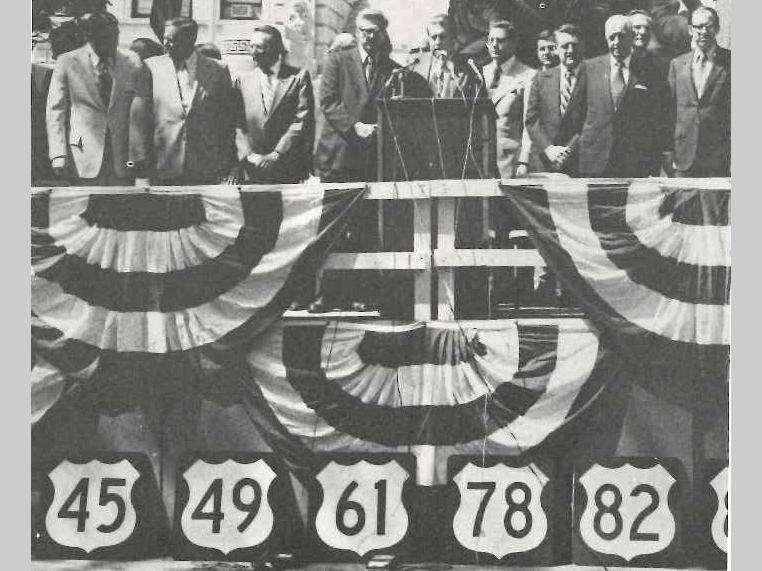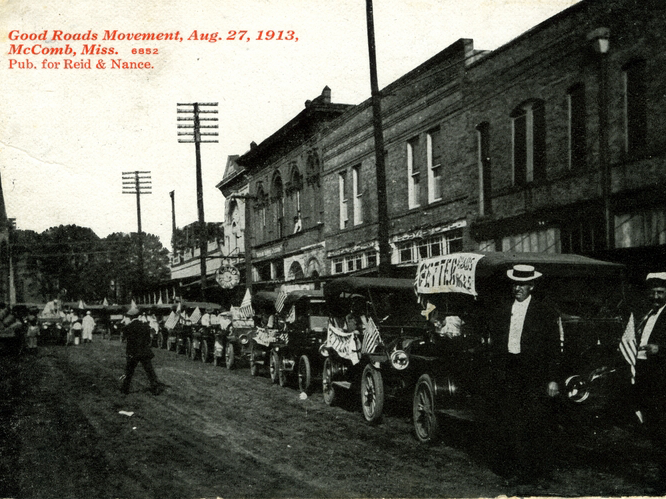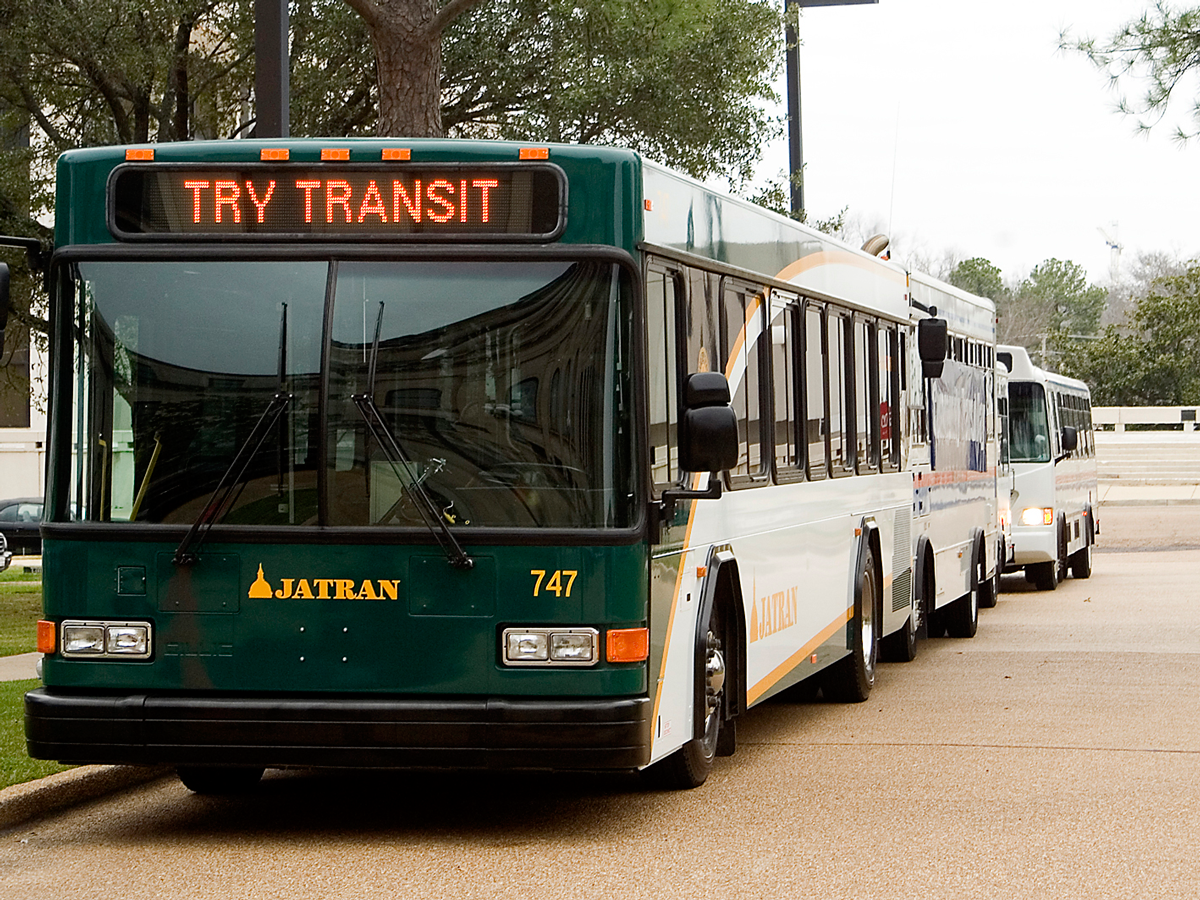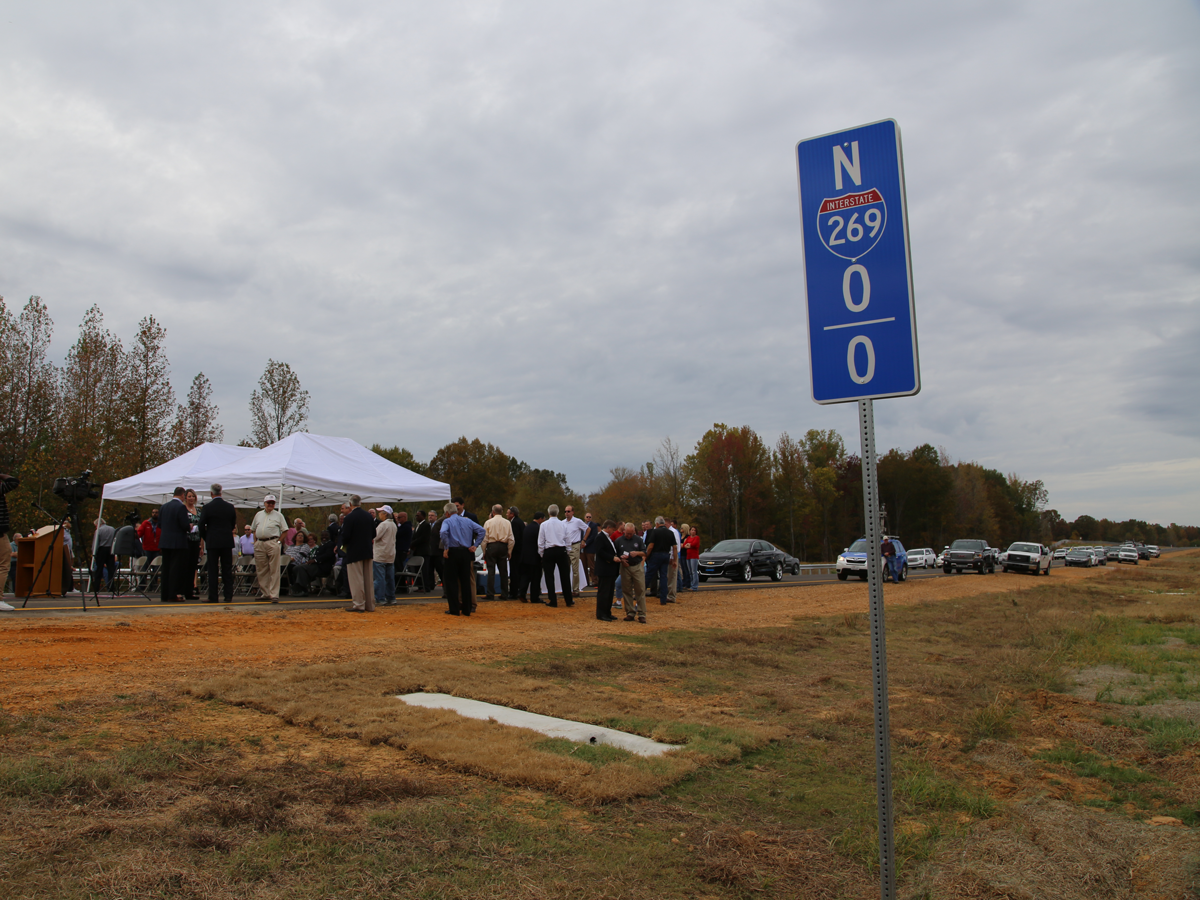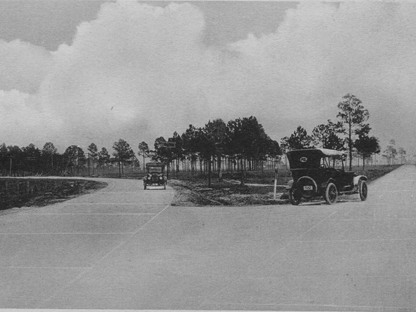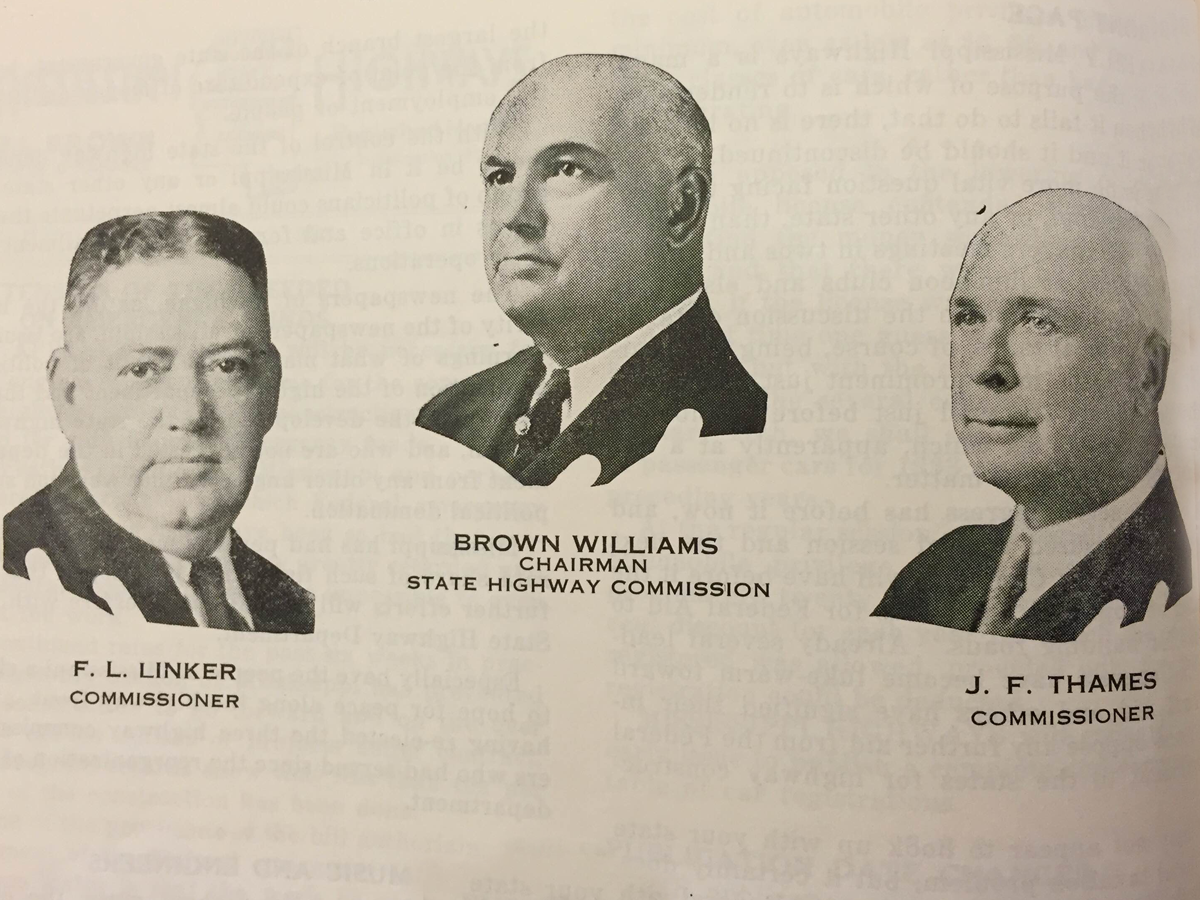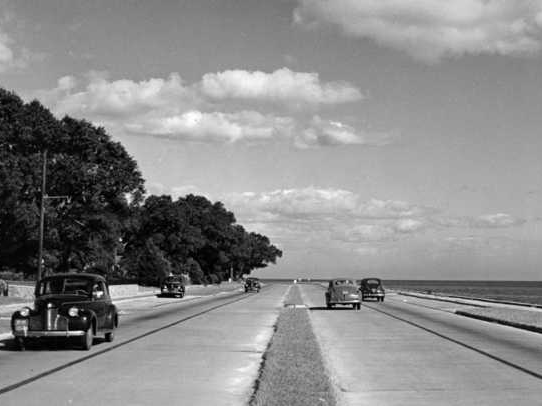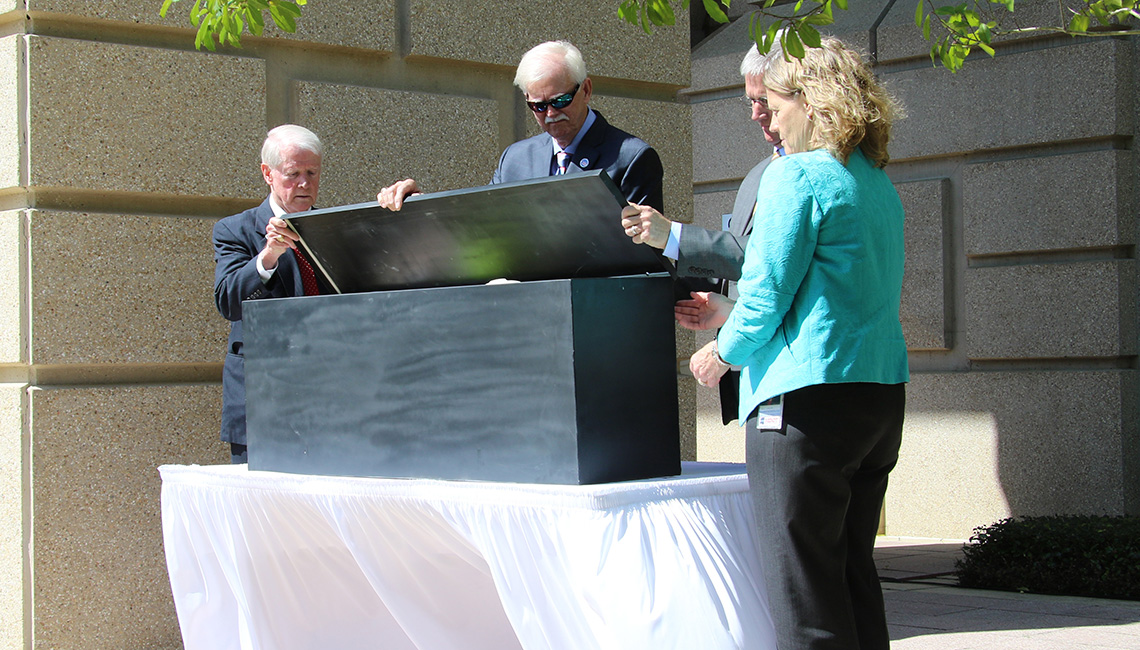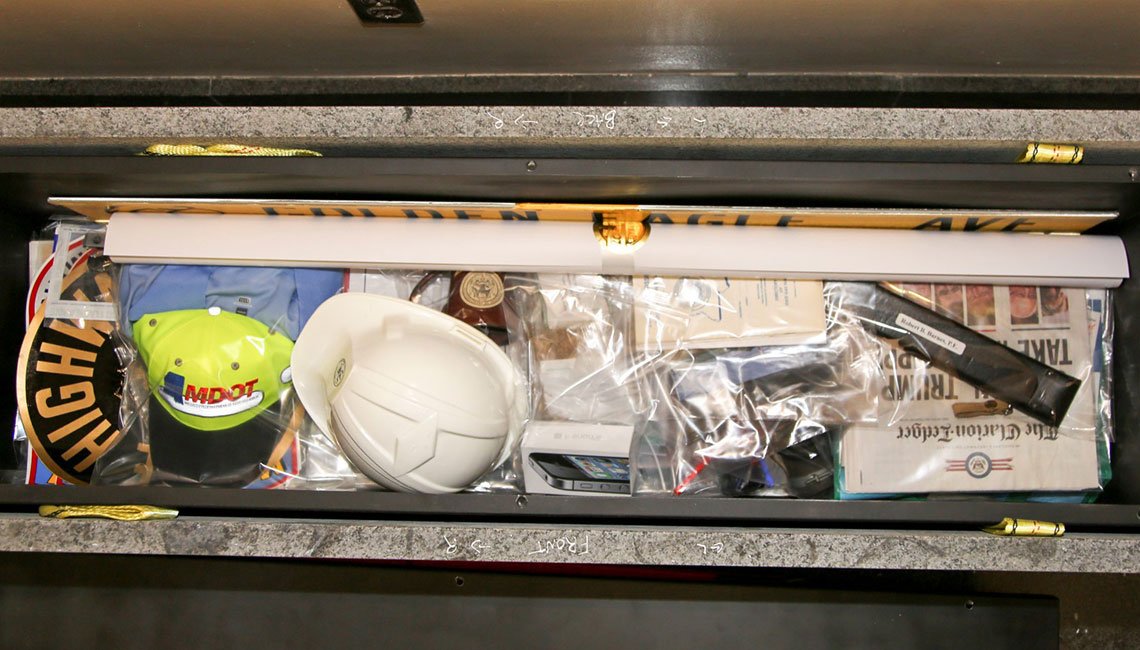Celebrating Mississippi's Transportation Story
On March 29, 1916, the Mississippi State Highway Commission was formed by the Mississippi Legislature. Explore the role transportation played in Mississippi's development over the past 100 years on the interactive timeline below or read more about its rich history.
In 1900, 20 automobiles were reported throughout Mississippi. The only paved road in the state was built in Lee County in 1915. By 1916, the number of automobiles in the state had increased to 24,000. With such a significant increase in the number of vehicles, the Mississippi Legislature decided something had to be done about the state’s road system.
In 1916, the Mississippi State Highway Commission was formed by the Mississippi Legislature with three elected commissioners to act in a supervisory capacity in the administration of federal funds allotted to the state and to work with the Federal Bureau of Public Roads on planning a system of highways. The bill was signed on March 29, 1916, passing the first state speed limit law which restricted travel to 15 mph in towns and 30 mph outside of populated areas. Four years later, the highway system was reorganized to broaden the scope of the Commission’s work, and it expanded to eight members elected from each of the state’s congressional districts.
As the United States formally ended World War I by declaring peace with Germany in 1921, the Federal Aid-Highway Act passed perfecting the Federal-Aid Highway system created in 1916. The states designated their federal-aid systems but were limited to only seven percent of total road mileage. The state’s first gasoline tax was collected a year later in 1922. The law set guidelines for the collection of a one cent tax per gallon of gasoline purchased for use in vehicles. In 1924, for the first time, the Legislature established and defined a system of state highways. The Board of Supervisors in each county was required to build the roads while the State Highway Commission was responsible for maintaining them. That year, the Legislature officially designated 78 roads. By 1926, the designation almost doubled to 135.
As America entered the Great Depression following the stock market crash of October 1929, the Mississippi Legislature enacted the “Stansel Act” in 1930 creating the first effective Highway Department and highway system in the state. This law changed the number of highway commissioners from eight to three. This three-member elected Highway Commission (elected from each of the Supreme Court districts) had full and general supervisory responsibility over all highway matters and the authority to appoint an Executive Director of the State Highway Department with responsibility over the day to day operation of the agency. The law established a system of highways by designating each road which provides reasonable connection between county seats, state institutions or other places with a population of 500 or more. The law also gave complete control of the state highway system to the Highway Commission. This included power to locate, relocate, widen, alter, change, straighten, construct or reconstruct any and all roads.
Between 1930 and 1936, attempts were made to enact legislation calling for a statewide bond issue in order to provide funds for construction and paving purposes, but not until 1936 was a definite step made toward that end. That year, the Legislature took advantage of the Federal Aid Act permitting matching of public works funds with state funds on a 55/45 basis and authorized $23 million to be spent on the roads of priority designation, which were principally U.S. numbered highways. The 1938 session of the Legislature authorized the sale of $60 million in bonds for additional construction purposes and created the State Bond Commission. By 1940, the Benjamin G. Humphreys Bridge was built connecting Greenville with Lake Village, Ark. Before the bridge’s opening, the only way to get freight or vehicular traffic across the river was by ferry. With a main span of 840 feet, at the time, it was the longest span for a highway bridge anywhere on the Mississippi River. The Natchez-Vidalia Bridge, which also opened in 1940, became the second bridge over the Mississippi River in the state. This two-lane bridge carried Highway 84 traffic from Natchez to Vidalia, La. An additional bridge was completed in 1988, expanding traffic to four lanes and in 2015, MDOT completed a unique, once in a lifetime project replacing the 75-year-old pins and links from the original bridge.
From 1938 to 1941, the Highway Department was involved in the largest construction program of highways in the state with little or no legislation. Due to World War II, the Legislature took no action until the 1948 session, where it increased the designated mileage of the primary and secondary system to 10,000 miles. The 1944 Highway Act was the first law to stipulate that a system of highways would be built to design specifications which would serve anticipated traffic 20 years after the design date. Congress approved the Federal Interstate Highway Program which included four of Mississippi’s truck highways. In 1946, a $30 million bond issue was authorized by the Mississippi Legislature to match Federal Aid.
In 1956, life was given to the interstate system with the establishment of the Federal Highway Act, which piloted the interstate highway era. The law allowed the Federal Government to provide 90 percent of funds necessary for the construction of interstates. Soon, there were interstate projects underway, connecting Mississippi’s most northern edge to the Louisiana border and the Mississippi River to the Alabama state line. The Highway Trust Fund was established as a bank for federal monies which were obtained from certain federal road taxes on fuel, tires and other items. Two years later, a $4 million bond issue was authorized by the Legislature for the purchase of Natchez Trace rights-of-way, and these bonds were exempt from the limitation imposed by the laws of 1956. By 1962, interstate funds were distributed equally according to need in the north, central and southern highway districts. Interstates 55, 20, 59, 220 and 10 were born using federal and local funds to create the foundation for the interstate system used today.
The Legislature authorized the $300 Million Bond Program in 1969, rescinding the $95 million limitation imposed by the laws of 1966 and established a $25 million limitation on new bond issues to match Federal Aid. This bond was backed by a gas tax and priority bill which required the Highway Commission to four-lane and reconstruct older roads on basis of use and importance. In Mississippi, 1972 marked the election of Governor William L. Waller and significant investments in infrastructure. Work on the Tennessee-Tombigbee Waterway began with efforts to provide economic and industrial benefits by linking the port of Mobile to ports on the Ohio and Mississippi Rivers. That same year, $600 million Highway Corridor Program was passed, calling for approximately 1,200 miles of four-lane highways to be constructed resulting in large economic productivity in almost every area of the state.
Over two decades after the bridges in Natchez and Greenville opened, Mississippi saw the birth of the Helena Bridge in 1961. The bridge connects Lula to Helena, Ark. and carries Highway 49 across the Mississippi River. In 1973, the Vicksburg Bridge opened, carrying I-20 over the Mississippi River from Vicksburg to Delta, La. This bridge was the state’s fourth bridge across the Mississippi River and was built next to the Old Vicksburg Bridge, which carried Highway 80 across the river.
In 1981, the passage of House Bill 1383 shifted highway investment priorities from construction to maintenance of existing roads, and in 1987, the Mississippi Legislature passed a long-range highway program, which was one of the most comprehensive in the country. The development of Mississippi’s transportation system over the past 25 years has grown in large part due to the provisions of this act which came to be known as the 1987 Four-Lane Highway Program or Advocating Highways for Economic Advancement and Development (A.H.E.A.D.). This program was designed as a means to fund the effort of moving Mississippi’s citizens and goods through a shared vision among legislative leaders and grass-roots advocates.
A.H.E.A.D. contained four major provisions that set it apart from other construction programs. First, the program established priorities as to which corridors should be constructed first. Second, it set tangible long-range goals. Third, it used a “pay as you go” funding philosophy. Finally, it dedicated all highway-user revenues to highways. The legislation also allowed the Highway Department the flexibility to maximize the use of federal funding by allowing the substitution of federal funds for state funds on maintenance projects. The program called for highways to be built in phases based on vehicle count and road capacity. Three phases were established with each having a mileage goal and an estimated cost. The original drafters of the 1987 program intended that the work be completed in phases that overlapped each other with most of the work being conducted in Phase II. Highway user revenues were dedicated to build the system.
In July 1992, the State Highway Commission and Highway Department were reorganized into the Mississippi Department of Transportation (MDOT) which is governed by the Mississippi Transportation Commission. Similar to the previous Highway Commission, the state of Mississippi vests oversight of its transportation resources and operations in a three-member elected Commission representing three geographic areas in the state—Central, Northern and Southern. In accordance with state law, the Commissioners have the authority and responsibility for the supervision of all modes of transportation in the state dealing with aeronautics, highways, public transit, ports and rails.
The Transportation Commission is authorized to appoint an Executive Director of MDOT responsible for administering the policies of the Commission and exercising day to day supervision over administrative and technical matters relating to airport and port development, highway construction and maintenance, weight enforcement, public transit and rail safety. Today, the organization has expanded to over 3,400 employees with 35 divisions and six districts.
In 1998, MDOT was given authority to borrow $200 million through revenue bonds if funding resources dictated. Among sources designated to pay for the program were a motor fuel tax, a $5 vehicle registration (car tag fee), a highway contractor’s tax, federal aid and proceeds from the revenue bonds. Phase IV was then incorporated into Vision 21, a needs-based highway program, during the 2002 Legislative Session. MDOT’s goal at the inception of the 1987 program was that every Mississippian would be linked to a four-lane highway within 30 miles or 30 minutes. MDOT continues to make strides toward reaching that goal. Mississippians have already realized the increase in economic activity and safety of four-lane highways.
In 2002, the Mississippi Legislature established the Multi-Modal Transportation Improvement Program to provide funds for high priority improvement projects to airports, ports, railroads and public transit systems for which funds are not otherwise available. By providing $10 million annually to support the Multi-Modal Transportation Improvement Program, MDOT is further sustaining an efficient and effective intermodal system by balancing modal investments. This program remains a valuable resource for leveraging strategic investments throughout the state.
One of MDOT’s top priorities has been to replace Mississippi’s deficient bridges. This has been an ongoing process throughout the state. The Bridge Replacement and Rehabilitation Program provided funding assistance for any bridge on a state designated road. Federal law allowed between 15 and 35 percent of the funds to be used at the local level. In 2004, MDOT reported a total of 5,481 bridges on the state maintained highway system. Of that figure, 1,223 (or 22 percent of the bridges) were considered structurally deficient or functionally obsolete. The structures were sound but were no longer able to function at peak capacity. There were also 10,928 bridges on the non-state maintained system of which 3,378 (or 31 percent of the bridges) were considered structurally deficient or functionally obsolete in 2004. With these figures in mind, progress towards bridge replacement and rehabilitation has been pushed by transportation leadership in Mississippi. According to the Federal Highway Administration (FHWA), for many years Mississippi has built some of the most cost-efficient bridges in the southeastern portion of the United States. MDOT has been recognized by FHWA as a leader in the southeast in the total number of newly constructed bridges on the Federal-Aid System.
In 2005, Mississippi’s transportation history would be changed forever. Hurricane Katrina hit the Mississippi Gulf Coast on August 29, 2005, unleashing unprecedented damage to the state’s transportation infrastructure. Katrina’s powerful winds and storm surge left both the Bay St. Louis and Biloxi Bay bridges crippled beyond repair. MDOT funded all Katrina repair and clean up from August 2005 through January 2006 with the exception of $10 million made available by U.S. Secretary of Transportation Norman Minetta and FHWA Administrator Richard Capka. With much left to be accomplished, MDOT was out of funds. On January 23, 2006, $1.1 billion in FHWA Emergency Relief Funds was made available to MDOT. This federal funding was a validation of MDOT and FWHA’s plans, leadership and efforts. On May 17, 2007, MDOT celebrated the restoration of two-way traffic on the Bay St. Louis Bridge. The bridge is 85 feet high, 1.7 miles long, 150 feet north of the old bridge and has four 12-foot-wide lanes, an eight-foot-wide inside shoulder, a 10-foot-wide outside shoulder, a 12-foot-wide pedestrian lane and 22 pieces of artwork along the pedestrian walkway.
MDOT replaced the Biloxi Bay Bridge with a new high-level bridge using a design-build project delivery method which allowed the designing, engineering, permitting and construction activities to be conducted simultaneously. On November 1, 2007, MDOT opened the newly constructed Biloxi Bay Bridge. The 1.6-mile long bridge carries U.S. Highway 90 directly over the Biloxi Bay connecting Biloxi and Ocean Springs. The bridge is 95-feet-high, has six 12-foot-wide lanes, a 12-foot-wide pedestrian lane and 22 pieces of artwork by local artists incorporated into the railing along the pedestrian walkway. The dedicated and focused efforts of MDOT, FHWA and the design-build team assured the record rebuild of Katrina-damaged transportation infrastructure. The new bridges are higher, wider and longer than the structures they replaced, and Gulf Coast communities are now stronger and their future is brighter, as seen in projects that followed such as the Sangani Boulevard Interchange Project and the I-10/I-110 D’Iberville Boulevard Interchange Improvement Project in Harrison County; the I-10 Reconstruction Project and the Highway 607 Reconstruction and Expansion Project in Hancock County; and the Highway 90/Highway 611/Highway 63 Interchange Project in Jackson County.
A year later, in October 2008, MDOT completed Phase III construction of the Stack—a multilevel urban interchange of I-20, I-55 and Highway 49—in Jackson. The Stack dramatically reduced traffic congestion and the number of crashes, while improving travel and cutting local commute times in half. Traffic traveling through the city, including tractor-trailers and other commercial motor vehicles, also experience a more predictable and less-confusing journey on this vital cross-country route in Mississippi’s capital city.
In 2010, the state was focused on bridge projects including the U.S. Highway 82 Mississippi River Bridge that links Mississippi and Arkansas. This structure originally replaced the Benjamin G. Humphreys Bridge that had weathered the wrath of the Mississippi River and ever-increasing volumes of highway and river traffic. Since 1972, according to government statistics, the old bridge had sustained more barge collisions than any other bridge on the Mississippi River and even had an airplane crash into it in 1953. MDOT began designs for the replacement bridge in 1995, and in 2005, the Mississippi Approach Contract was let at an estimated cost of $86.1 million followed by the Arkansas Approach Contract that was let at an estimated cost of $52.4 million.
On July 28, 2010, MDOT celebrated the grand opening of the new $336 million U.S. Highway 82 Mississippi River Bridge. The bridge connects the Mississippi Delta to Interstate 55 and other four-lane highways such as U.S. Highway 61 and U.S. Highway 65 in Arkansas. Each lane is 12-feet wide with 12-foot outside shoulders and 8-foot inside shoulders to further enhance safety and traffic flow. The entire bridge deck is 2.5 miles, and the total project length is more than 3.8 miles. The main span portion of the new bridge included four deep river piers anchored 20 feet into the riverbed, two concrete towers soaring 425 feet above the Mississippi River and a spectacular cable-stayed span supported by four fans of pre-stressing strand steel cable. The 1,378-foot center-span is the longest cable-stayed span in the continental United States. The new bridge was constructed in a straight section of the river and is much less susceptible to collisions from barge traffic.
Less than a year later, MDOT broke ground on a three mile section of I-269 in DeSoto County on June 23, 2011. As growth continues in DeSoto and Marshall Counties, the new I-269 will be a valuable asset, providing a safer and more efficient way for commercial vehicles to move goods throughout the region. Forming a 30-mile loop around Memphis, I-269 will relieve traffic pressure on the I-55/69 corridor and connect I-40 and I-55 in North Mississippi. I-40 is a major cross-country freight route, and I-69 will be an international connector between Canada and Mexico. In addition, this interstate will be vital in promoting economic growth and development in the region. Construction of I-269 is divided into eight individual projects. The first section of I-269, from Highway 302 to the Tennessee state line in Marshall County, opened to traffic on October 22, 2015. I-269 is expected to be completed by fall 2018.
In July 2011, 9.5 miles of four-lane construction began on State Route 9 in Pontotoc County to improve existing transportation infrastructure and accommodate future growth and economic development in the area. These needs became necessary after Toyota’s decision to locate a production plant in Belden. Safer and more durable roads with better access to the west and southwest areas of the plant were needed. On August 16, 2012, MDOT held a ribbon cutting ceremony for the new State Route 9. In addition to the 9.5 miles of new four-lane highway constructed, road work also included 7 million cubic yards of earthwork, approximately 170,000 tons of asphalt, 10 bridges and one interchange. The State Route 9 construction was an invaluable investment to help support growth and economic development throughout North Mississippi.
In the central region of the state, MDOT began construction of the Split Diamond Project in Madison on May 10, 2012. The project reconstructed a section of I-55 from Old Agency Road in Ridgeland to State Route 463 in Madison while constructing a split diamond interchange between Madison Avenue and the proposed Colony Park Boulevard. The project called for the addition of two lanes to I-55 in each direction for a total of eight lanes, the addition of frontage roads to the interstate between the Old Agency Interchange and Madison Avenue, the widening of a portion of Madison Avenue to five lanes and building a portion of the new Colony Park Boulevard. The project strengthens the local transportation infrastructure, improves the safety of the traveling public and supports future economic development in the area.
In June 2015, MDOT unveiled a new innovative interchange at I-10 and D’Iberville Boulevard in the city of D’Iberville. The Diverging Diamond Interchange (DDI) is a new system being implemented across the country as a safer, more efficient alternative to traditional interchanges. Adopted from European systems, the DDI is proven to both significantly reduce crashes and improve traffic flow. The D’Iberville Boulevard DDI is not only the first of its kind in Mississippi, but this special split design DDI is the first of its kind in the U.S. This system not only eases traffic congestion along D’Iberville Boulevard, it also provides a safer way to enter and exit I-10.
Although Mississippi has managed to develop a robust transportation system, funding continues to fall short of the state’s infrastructure needs. While road construction costs have increased 300 percent, state and federal dedicated transportation revenues have remained flat for the last decade and long term funding remains uncertain. MDOT has been forced to shift to a maintenance-only approach and focus on system preservation. MDOT remains committed to building a transportation infrastructure that will sustain future economic growth for the next 100 years. With limited resources, MDOT will continue working to find innovative solutions to ensure the preservation of the transportation network. Transportation is the driving force of a strong economy.
Throughout 2016, MDOT celebrated 100 years of service by recognizing several major milestones that shaped that state’s transportation history. A centennial event was held on the anniversary of the establishment of the State Highway Commission. During the ceremony at MDOT’s Administration Building in Jackson, Mississippi Native and American Country Music Recording Artist Steve Azar performed. Current and past Commissioners and MDOT leaders; national, state and local elected officials; current and former MDOT employees; the state’s Miss Hospitality and the public celebrated the past century of transportation history in Mississippi.
At the centennial anniversary event, to preserve a visual record of what the world, state and transportation looked like over the past century, a time capsule was sealed by the Mississippi Transportation Commission where it will remain sealed until March 29, 2066. From photographs to technology and maps to manuals, the time capsule will inform the public about the projects, priorities and people of MDOT over the past 100 years. MDOT also unveiled a memorial in honor of its fallen workers to serve as a tribute to the workers who lost their lives in service to transportation in Mississippi.
Mississippi's Transportation Leadership
On April 14, 1916, the Mississippi Transportation Commission held their first meeting to act in a supervisory capacity in the administration of federal funds allotted to the state and to work with the Federal Bureau of Public Roads on planning a system of highways.
While the structure of the Commission has changed over the years, the mission of the Transportation Commission has remained consistent. Today, the three-member elected Commission represents the electorate in the Northern, Central and Southern districts of the State of Mississippi as defined by the Supreme Court Districts. In accordance with state law, the Commissioners are responsible for planning, developing and coordinating a comprehensive, balanced intermodal transportation policy for the state. In addition, the Commission appoints an Executive Director of MDOT to carry out the day-to-day policies and procedures of the agency.
Transportation Commissioners
| Central | Northern | Southern |
|---|---|---|
| J.M. (James Marcus) McBeath, 1916 - 1930* | D.W. Robins, 1916 - 1930 | W.T. Denman, 1916 - 1936 |
| Thomas Brown Williams, Sr., 1930 - 1937 | F.L. (Abe) Linker, 1930 - 1940 | H.J. (Hiram) Patterson, 1936 - 1943 |
| Sidney Theodore Roebuck, 1937 - 1951 | T.J. Lowry, 1940 - 1947 | Mundell Bush, 1943 - 1948 |
| Felder Dearman, 1952 - 1967 | Roy C. Adams, 1947 - 1967 | John D. Smith, 1949 - 1967 |
| Sam Waggoner III, 1967 - 1988 | Herschel G. Jumper, 1967 - 1975 | W.H. (Shag) Pyron, 1967 - 1979 |
| Wayne Burkes, 1989 - 1999 | Bobby Richardson, 1976 - 1983 | Bob Joiner, 1979 - 1988 |
| Dick Hall, 1999 - Present | Zack Stewart, 1984 - 2003 | Ronnie Shows, 1988 - 1998 |
| Bill Minor, 2004 - 2010 | Wayne Brown, 1999 - 2011 | |
| Mike Tagert, 2011 - Present | Tom King, 2011 - Present |
In 1920, Governor Lee Russell created an eight member Transportation Commission by appointing five new Commissioners to serve in addition to the three Commissioners in office. The appointed Commissioners served until an election was held on the first Monday in January 1921. This eight member commission was abolished in 1930 and an elected commission consisting of three members was re-established through the "Stansel Act" of 1930.
Transportation Commissioners, 1921 - 1930
| District 1 | D.W. Robins |
| District 2 | S.W. Mullins* |
| District 3 | J.C. Roberts* |
| District 4 | W.A. Boone* |
| District 5 | J.M. McBeath |
| District 6 | Fred W. Smith* |
| District 7 | W.T. Denman |
| District 8 | R.J. Henry** |
The Transportation Commission is authorized to appoint an Executive Director of MDOT responsible for administering the policies of the Commission and exercising day to day supervision over administrative and technical matters relating to airport and port development, highway construction and maintenance, weight enforcement, public transit and rail safety. From 1930 until 1992, the Executive Director managed the day to day operation of the State Highway Department. In July 1992, the State Highway Commission and Highway Department were reorganized into the Mississippi Department of Transportation which is governed by the Mississippi Transportation Commission. Today, the organization has expanded to over 3,400 employees with 35 divisions and six districts.
Executive Directors
| Mississippi Department of Transportation |
|---|
| Melinda McGrath, 2011 - present |
| Larry L. (Butch) Brown, 2001 - 2011 |
| W. Hugh Long, 2000 - 2001 |
| Kennith I. Warren, 1998 - 2000 |
| Dr. Robert L. Robinson, 1993 - 1998 |
| John R. Tabb, 1992 - 1993 |
MDOT 100 Moments
Explore the Magnolia state’s evolving infrastructure system in this video series. Find your MDOT 100 moment.
1924
Mississippi's First Highway System1930
The Birth of Mississippi's Transportation Infrastructure1940
Bridging the Mississippi River1956
Federal-Aid Highway Act1972
$600 Million Highway Investment1987
A.H.E.A.D. Enacted1992
The Mississippi Department of Transportation Formed2002
Multi-Modal Transportation2007
Bay St. Louis and Biloxi Bay Bridges Reopen2008
"The Stack" is Completed2015
Interstate 269MDOT would like to thank American singer-songwriter recording artist and Mississippi's very own Steve Azar for providing his voice talents to the “MDOT 100 Moment” video series. For more information about Steve Azar, visit www.steveazar.com
Connect with @MississippiDOT on social media to find your favorite #MSDOT100 moment.
Sharing Our MDOT 100 Moments
In 2016, MDOT celebrated 100 years of service to the people of Mississippi and shared transportation stories through this MDOT 100 Moment video series.
Time Capsule
From photographs to technology, maps to manuals, the Mississippi Department of Transportation sealed a time capsule celebrating 100 years of service to the people of Mississippi on March 29, 2016, to be opened in 50 years on March 29, 2066.
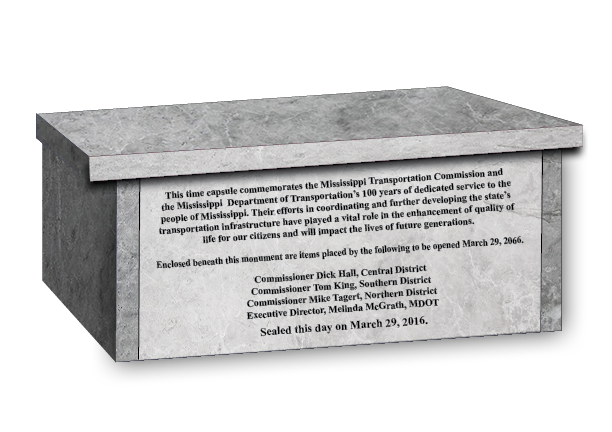
This time capsule commemorates the Mississippi Transportation Commission and the Mississippi Department of Transportation’s 100 years of dedicated service to the people of Mississippi. Their efforts in coordinating and further developing the state’s transportation infrastructure have played a vital role in the enhancement of quality of life for our citizens and will impact the lives of future generations.
Enclosed beneath this monument are items placed by the following to be opened March 29, 2066.




